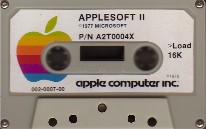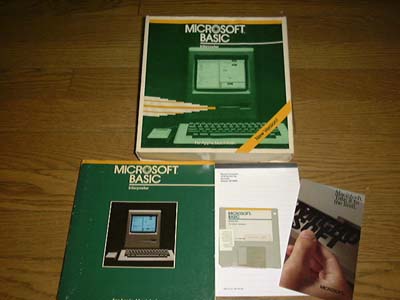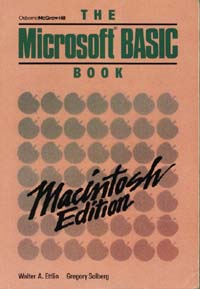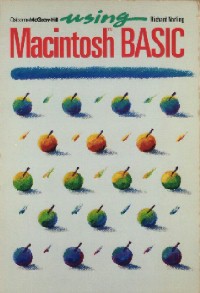
My AppleII Notes-6
99/7/18@Genealogy of Apple Computer and BASIC

A
book named "Apple Confidential" by Owen W. Linzmayer arrived at my house.
It is "The Real Story of Apple Computer, Inc.", which
I expected, but the contents were almost the same as those of the author of
"The
Mac Bathroom Reader" - (
My Favorite Books
reference 5)
.
The book had changes in Layout and in addition had stories surrounding Apple
since 1995 including compatible machines, BeBox, BeOS, and iMac. They also
featured an article about the return of Steve Jobs.
It seems we are able to purchase a copy of "Apple Confidential" and "The Mac
Bathroom Reader" from Linzmayer's Website (
Http://Www.Netcom.Com/`owenink).
While the following is something that I saw in a previous copy, it was
interesting to read it again, as usual:
In
the chapter on Macintosh BASIC, the following episodes are introduced as
failures of Bill Gates. In August 1977, Apple signed a license agreement with
Microsoft to acquire the Microsoft version of BASIC and paid $ 21,000 for 8
years.
This BASIC program was reworked by Randy Wigginton
for Apple II, released as Applesoft
hh
and installed on all Apple II.
Although
the developed BASIC did not take advantage of the features of the Macintosh, it
was released in accordance with Macintoshfs announcement (January 24, 1984).
· In parallel to this, Jobs asked internal
programmer Don Denman to develop Apple's own version. It would be released at 99
dollars in the second quarter of 1984.
Bill
Gates agreed to license Applesoft BASICfs Apple II after 1985, in exchange for
the discontinuing development of MacBasic.
(Since then, until November 15, 1993, Apple II continued to sell, contributing
to Apple's revenue)
Meanwhile, Don Demann
is totally unaware of the circumstances of this negotiation and is informed of
development cancellation from co-author of the MacBasic manual.
Microsoft BASIC for Macintosh is discontinued after a
spectacular sales performance has not been realized.
Bill Gates later says, "It was the most foolish deal
ever made."
Published in 1999, by Owen W. Linzmayer,
No Starch Press, Inc., 577page, B5
Two types of Apple II BASIC
In 1964, the BASIC language developed by two professors, John Kemeny and Thomas
Kurz of Dartmouth University, was widely adopted by the educational sector.
In the autumn of 1974 Bill Gates, a student at Harvard University, his friend
Paul Allen and Marty Davidoff,
who contributed greatly with floating point routines, developed BASIC for MITS
Altair using Intel's 8080 chip.
Then γΙMicrosoftΠπn§Blater
went on to found the Microsoft Company.
 |
 |
 |
To compensate
for this weak point, Apple got a Floating Point version of 6502 BASIC from
Microsoft, the so called Applesoft.(10K Basic). (November 1977)
Applesoft was supplied in the form of a tape, and
Randy Wigginton, who was a high school student at the time, modified and
improved
it for Apple II and it was then released as Applesoft II in
August 1978.
In the fall of 1979, Apple II Plus, instead of Integer BASIC, was installed as
standard on the Apple II ROM. (
See 1-Cards
)

Two BASIC ROM Cards.
Integer Basic ROM Card (top) and Applesoft BASIC ROM
Card (bottom)
The photograph below is of the Microsoft BASIC which was released at almost the
same time as the Macintosh release in 1984.
Mine are of the Microsoft BASIC version 2, which seems
to have been upgraded to accommodate the 512K release.

 |
The Microsoft Basic book
This is the Osborne Microsoft BASIC reference book published by
McGraw-Hill.
Macintosh Edition
As with the Macintosh Edition, this BASIC seems
to have been prepared for various machines.
Because Gates applied pressure on Apple not to
release Macintosh BASIC (Apple's license of Applesoft Basic for Apple II)
after 1985, the Microsoft BASIC for Macintosh was criticized as being
"bad" or that "it was not possible to access the Toolbox of the
Macintoshh.
Although it is actually designed to have access to the ROM routine, the
method of ROM CALL is explained in these books with sample programs.
The reason why this BASIC was selling poorly was not that the software was
bad, because Macintosh was rich in software applications such as;
MacPaint, MacWrite, Microsoft Chart, Multiplan, File, Chart and a number
of others. I think that it is more natural to assume that it was due to
the background whereby
the needs to develop programs in BASIC had not been fully met. |
 |
Using Macintosh Basic
Using Macintosh Basic" is a phantom reference book that was canceled
before release.
Because there are reference books, it seems that
they were preparing to start selling Macintosh BASIC.
The whole book is divided into 4 parts, 23 chapters, designed to allow the
user to write programs using graphics, a mouse and a Toolbox etc. There
are developments that allow the programmer to exploit the features of
Macintosh, but in order to fully understand the entire contents of
Toolbox, referencing the book Inside Macintosh is a must.
Although it is not an exact comparison, Microsoft BASIC Macintosh edition
is a rather rigid environment, but on the other hand, Macintosh BASIC has
an interactive debugger and I get
the impression that
can those who understand Macintosh firmware can work well with it, because
it is not confined to norms of conventional BASIC.
Donn Denman would have been frustrated knowing
that it was being discontinued.
|
|
|
Macintosh Basic Version 1.02
I own version 1.02, I remember that I got it at the shop
Hi-Tecs in Kodenma Town Tokyo. It
was being distributed as freeware in 1986.
(I made my own disk label by hand)
Macintosh Insiders
As with "The Mac Bathroom Reader" a previous publication, "Apple
Confidential" has updates on the members of the Macintosh development
team.
According to this book, the team members involved in the development of
Apple Computer Inc. BASIC are as follows:
Steve Woz: Teaching fifth graders to use computers at UNUSON.
Steve Jobs: left Apple in 1985, CEO of Pixar, and interim CEO of Apple.
Randy Wigginton: Left Apple in 1981, partner at consulting firm Media
Lane. |